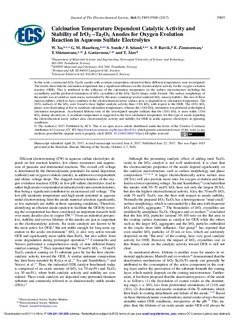| dc.contributor.author | Xu, Wenting | |
| dc.contributor.author | Haarberg, Geir Martin | |
| dc.contributor.author | Sunde, Svein | |
| dc.contributor.author | Seland, Frode | |
| dc.contributor.author | Ratvik, Arne Petter | |
| dc.contributor.author | zimmerman, erik | |
| dc.contributor.author | Shimamune, T | |
| dc.contributor.author | Gustavsson, J | |
| dc.contributor.author | Åkre, Torjus | |
| dc.date.accessioned | 2017-11-08T11:22:24Z | |
| dc.date.available | 2017-11-08T11:22:24Z | |
| dc.date.created | 2017-10-30T21:51:46Z | |
| dc.date.issued | 2017 | |
| dc.identifier.citation | Journal of the Electrochemical Society. 2017, 164 (9), F895-F900. | nb_NO |
| dc.identifier.issn | 0013-4651 | |
| dc.identifier.uri | http://hdl.handle.net/11250/2464892 | |
| dc.description.abstract | In this work, commercial IrO2-Ta2O5 anodes with a certain composition calcined at three different temperatures were investigated. The results show that the calcination temperature has a significant influence on the electrocatalytic activity for the oxygen evolution reaction (OER). This is attributed to the influence of the calcination temperature on the surface microstructure including the crystallinity and the preferred orientation of IrO2 crystallites of the IrO2-Ta2O5 binary oxide formed. The surface morphology of the anodes was revealed as mud-cracks surrounded by flat areas containing several scattered IrO2 nanocrystallites. The size of these nanocrystallites, which in turn contribute to the electrochemical active surface area, is dependent on calcination temperature. The (101)-surfaces of the IrO2 were found to have higher catalytic activity than (110) IrO2 with respect to the OER. The (101) IrO2 planes were dominating at low or moderate calcination temperatures, whereas the (110) IrO2 orientation was preferred at the highest calcination temperature. Accelerated lifetime tests of the investigated samples indicate that the (101) IrO2 is more stable (110) IrO2 during electrolysis. A moderate temperature is suggested as the best calcination temperature for this type of anode regarding the electrochemical active surface area, electrocatalytic activity and stability for OER in acidic aqueous electrolytes at operating conditions. | nb_NO |
| dc.language.iso | eng | nb_NO |
| dc.publisher | Electrochemical Society | nb_NO |
| dc.rights | Navngivelse 4.0 Internasjonal | * |
| dc.rights.uri | http://creativecommons.org/licenses/by/4.0/deed.no | * |
| dc.title | Calcination temperature dependent catalytic activity and stability of IrO2 – Ta2O5 anodes for oxygen evolution reaction in aqueous sulfate electrolytes | nb_NO |
| dc.type | Journal article | nb_NO |
| dc.type | Peer reviewed | nb_NO |
| dc.description.version | publishedVersion | nb_NO |
| dc.source.pagenumber | F895-F900 | nb_NO |
| dc.source.volume | 164 | nb_NO |
| dc.source.journal | Journal of the Electrochemical Society | nb_NO |
| dc.source.issue | 9 | nb_NO |
| dc.identifier.doi | 10.1149/2.0061710jes | |
| dc.identifier.cristin | 1509094 | |
| dc.relation.project | Norges forskningsråd: 228296 | nb_NO |
| dc.description.localcode | © The Author(s) 2017. Published by ECS. This is an open access article distributed under the terms of the Creative Commons Attribution 4.0 License (CC BY, http://creativecommons.org/licenses/by/4.0/), which permits unrestricted reuse of the work in any medium, provided the original work is properly cited. | nb_NO |
| cristin.unitcode | 194,66,35,0 | |
| cristin.unitname | Institutt for materialteknologi | |
| cristin.ispublished | true | |
| cristin.fulltext | postprint | |
| cristin.fulltext | preprint | |
| cristin.qualitycode | 2 | |

